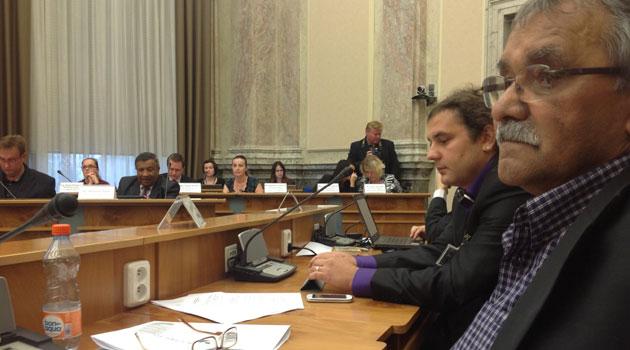Commentary: Why we need data about Romani pupils, and not only about them

“The discussion of the collection of sensitive data in the schools, i.e., data about disability or ethnicity, has been connected in the Czech Republic exclusively with tracking the number of Romani pupils,” Štěpán Drahokoupil of the Open Society Foundation Prague writes in a commentary first published by the news server “Česká škola” (Czech School).
“Questions repeatedly arise about the legality of such data collection, the reasons for collecting it and the use of it. This year the data collection is no longer being done by the Czech School Inspection Authority, but is being done by the Ministry of Education, Youth and Sport. Why is such data (sometimes called equal opportunity data) necessary at all, and why is its collection not a contravention of human rights?” he writes.
News server Romea.cz publishes the commentary in full translation below.
Why we need data about Romani pupils, and not only about them
The discussion of the collection of sensitive data in the schools, i.e., data about disability or ethnicity, has been connected in the Czech Republic exclusively with tracking the number of Romani pupils. Questions repeatedly arise about the legality of such data collection, the reasons for collecting it and the use of it.
This year the data collection is no longer being done by the Czech School Inspection Authority, but is being done by the Ministry of Education, Youth and Sport. Why is such data (sometimes called equal opportunity data) necessary at all, and why is its collection not a contravention of human rights?
We should want data about our schools
The story of data collection about pupils’ ethnicity in the Czech Republic is rather well-known. In the judgment of “D.H. and Others versus the Czech Republic”, the country lost a lawsuit almost nine years ago before the Grand Chamber of the European Court for Human Rights because of the systematic discrimination of Romani pupils in access to education.
One of the important pieces of evidence in that case was information about the disproportionate enrollment of Romani pupils into what were then called the “special schools” (zvláštní školy). As part of implementing the judgment, the Committee of Ministers of the Council of Europe regularly asks the Czech authorities for the numbers of Romani pupils being educated as pupils with “mild mental disability”.
The data reported by the Czech School Inspection Authority for the past three years unequivocally demonstrates that disproportionate diagnoses of pupils of Romani origin with “mild mental disability” persists. In the entire primary school system, approximately 3 % of pupils are given such a diagnosis, and of those 3 %, approximately one-third are ethnic Romani (even though Romani people represent less than 4 % of the entire population).
This data is also being required by the European Commission because the Czech Republic has been failing to fulfill the Racial Equality Directive and is at risk of being subjected to infringement proceedings. Only thanks to such data can we ascertain whether changes to address this at the level of curriculum, legislation and ministerial decrees are having an impact in practice as well.
We might complain that the bureaucrats in Brussels have invented yet another way to harass the Czech Republic, but the reality is that data about equal opportunities in the schools is mainly something that we here in the Czech Republic need. We need to be able to assess whether we are succeeding in fulfilling our educational aims and whether the declared principles of our laws are just words on paper, not reality.
A brief reminder: The first principle of the Schools Act is equal access to education, without discrimination, including discrimination on the basis of ethnic origin. Such discrimination is also banned by the Antidiscrimination Act.
The Czech Government Strategy for Education to 2020 has as its first priority reducing inequality in education. Logically, the Government’s Romani Integration Strategy to 2020 has reducing inequality in education among its aims also, and mentions the topic of the anonymous collection of data disaggregated by ethnicity.
How can we ascertain whether discrimination is happening and how pupils of various ethnicities are doing if we do not collect data disaggregated by ethnicity? One of the recent studies on such data collection in Europe names the problem quite well in its title: “No Data – No Progress“.
How to identify ethnicity
Even if we are convinced data collection is necessary, we cannot overlook questions about methodologies for collecting it or how to secure it. The Czech School Inspection Authority, and previously the Office of the Public Defender of Rights, have published such data in a form that makes it absolutely impossible to trace a specific pupil at a specific school from it.
The data is collected anonymously and there are no lists kept of pupils anywhere that include information about ethnicity, so it is not at all appropriate to compare this data collection with the counting of Jewish people by the Nazi regime. However, when explaining why data collection is important, we must unequivocally take account of that negative historical experience in particular.
When it comes to methodology, several options are available to us, but essentially there are only two that are the most frequently discussed: Identification by a third party, and self-identification (more on other options and the topic of data collection is available in a briefing paper by the Open Society Foundations). Both methods have positive aspects and both pose risks.
The Czech School Inspection Authority, just like the Ministry of Education, Youth and Sport and the Public Defender of Rights, uses third-party identification. This method is frequently criticized because it involves superficial assessment and guesswork and does not take into consideration whether a child considers herself to be a member of the group in question.
In other words, identification by a third party uses the same assessment method chosen by those who discriminate against others. However, if, for example, somebody does not let a Romani person into a bar, or refuses to lease an apartment to a Romani person, or diagnoses a Romani person with “mild mental disability” for no reason, then the discriminator certainly does not ask the Romani person ahead of time whether he or she actually identifies as Romani, but simply makes the identification on the basis of superficial criteria, i.e., whether the person seems Romani in that society.
Thanks to this method, we may “only” generate qualified estimates, but such data is decidedly better than relying just on a general “feeling” about numbers that might be more based on prejudice than on reality. The other method to use would be self-identification, where each person being counted has the option of expressing herself independently when answering this question, and which depends on the person’s identification of herself, not on how others perceive the person.
We can also anticipate that, according to the self-identification method, the person would be more informed and could actively contribute to the counting being done. The number of Romani people who self-identify during the regular census of the population of the Czech Republic, however, demonstrates the biggest disadvantage of the self-identification approach.
When, among Romani people, there is not sufficient belief in the safety of the census process for them to self-identify as Romani during it, we get absolutely absurd numbers as a result in which the number of Romani people in the whole country is approximately 13 000. Be that as it may, neither data collection approach contravenes either Czech or international documents about human rights.
Meaningful restrictions (anonymization, security) exist when processing and using this sensitive data, and as long as those restrictions are upheld, such data collection is possible. In any event, if we were to use the self-identification with minors, their parents’ consent would be necessary, but during identification by a third party, it is not.
Under conditions of sufficient data protection and its correct use, data about equal opportunities is absolutely crucial. A recently published commentary by the UN on inclusive education elaborates on the fulfillment of the UN Convention on the Rights of Persons with Disabilities, which also mentions the need for data. and indicates insufficient data about the schools in the Czech Republic is one of the barriers to implementing high-quality, inclusive schooling here.
Demonstrating change
An integral component of the discussion of data collection is the aim of the collection and how the data are used. In the Czech Republic, the number of Romani pupils educated as pupils with “mild mental disability” will be used to demonstrate whether access to education remains unequal for such children.
The fact that there is no longer a separate education program authorized for use with pupils with “mild mental disability” changes nothing about the question of whether Romani pupils will continue to be disproportionately diagnosed with that condition. Similarly, the transformation of the “special schools” (zvláštní školy) to what are today called the “practical” schools did not make discrimination disappear.
Any change in this area should be demonstrated by data disaggregated by ethnicity. The aim is to reduce inequality for Romani pupils.
Anybody who wants to exploit hateful, xenophobic sentiment in society could use exactly this same data to allege, for example, that Romani pupils are simply “worse” than ethnic Czechs – otherwise so many of them would not be in special education. Merely noting the correlations in the data is not enough – we must go beyond them to explain the reasons for the existing inequality and then to do our best to reduce them.
One example of how such data are used comes from the United States of America. While that country may have, according to former Secretary of State Hillary Clinton, a bigger problem now with racial segregation than existed during the 1960s, the reason the Government even knows this is because, thanks to data collection, they have been able to follow changes in the distribution of children of various ethnicities in the schools over the course of time.
Studies mapping segregation since the 1960s, ever since the Brown vs. Board of Education decision (the D.H. and Others judgment against the Czech Republic is, according to some, the European version of that judgment) demonstrate that the typical African-American child will attend a 30-pupil class in which eight pupils are white and 20 are African-American, while the typical white child will have 22 white and two African-American classmates. When we look at how segregation has developed in the American South, studies demonstrate that prior to 1968, three out of four African-American students attended segregated schools, but after the introduction of desegregation plans, that number fell by one-fourth over the next 20 years.
In the year 2011, however, that number rose again, and every third African-American student was being educated in almost an exclusively black school in the American South. The mere collection of data, therefore, does not change anything about the degree of segregation in and of itself, but thanks to such data, it is possible to follow the impact of measures supporting inclusion.
When collecting data about Romani pupils, the discussion must always take place as to why this data collection is being done, what purpose it serves, and how the data are secured and used. For the purpose of revealing inequality in education, data disaggregated by ethnicity is absolutely essential, and this information should be used mainly by the Czech state and then by the Council of Europe and European Commission.
It is legitimate to ask why data should only be collected about Romani pupils. The answer to that question is not to stop collecting such data, but to expand its collection so we can have data about other groups at risk of unequal access to education.
The author works for the Open Society Foundation Prague. First published in Czech by the news server Česká škola (Czech School).
